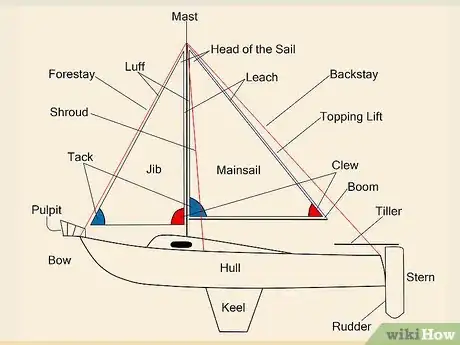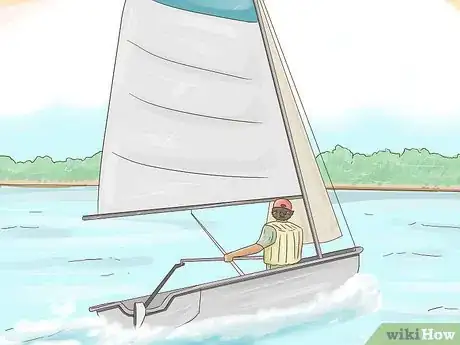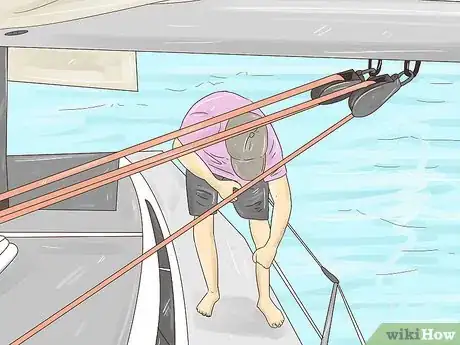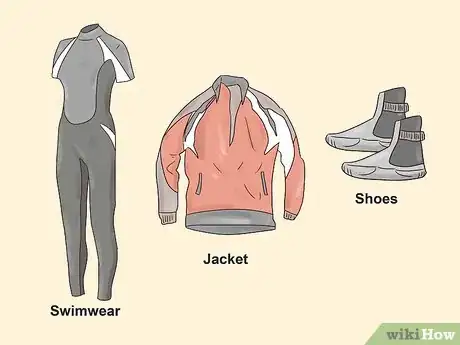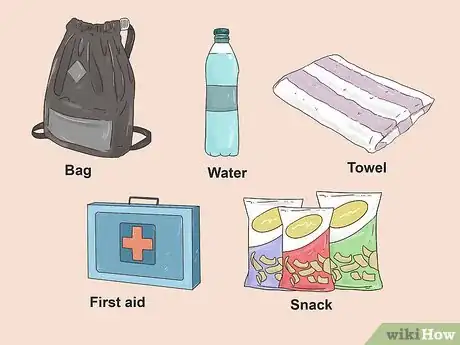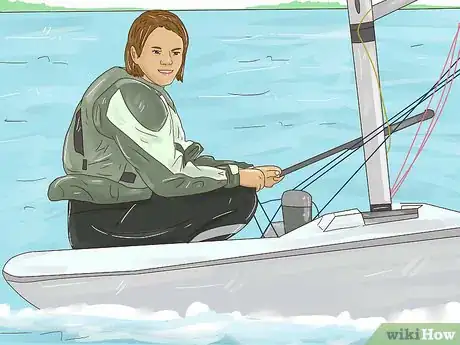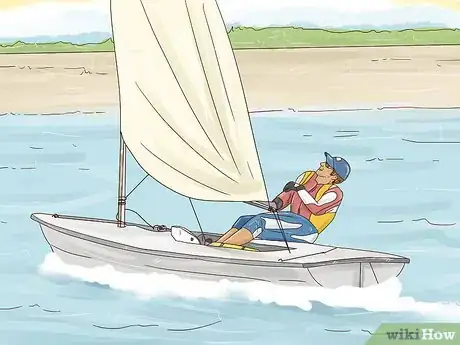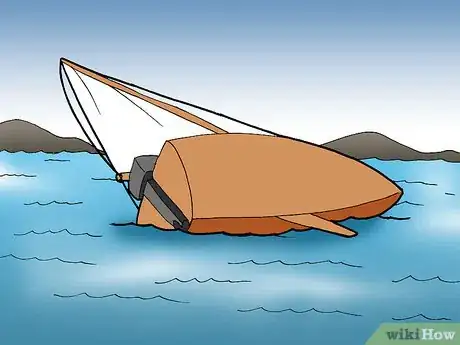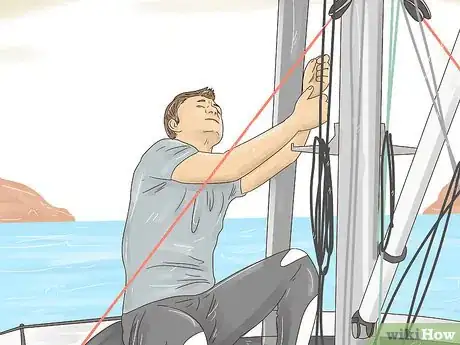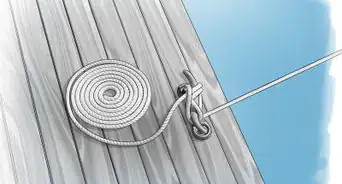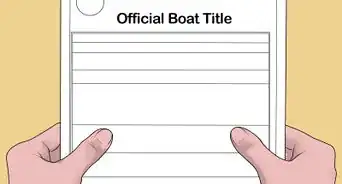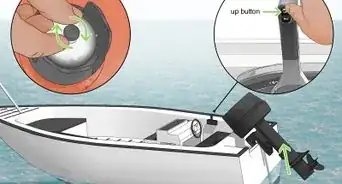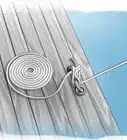This article was co-authored by Nitzan Levy. Captain Nitzan Levy is a Sailor, Social Entrepreneur, and the Founder of Sailors NYC, a recreational sailors’ club based in Jersey City, New Jersey that specializes in cruising boats and a variety of community programs. Capt. Levy has over 20 years of sailing experience and has sailed in many places around the world including: the Atlantic Ocean, the Mediterranean Sea, The Caribbean, and the Indian Ocean. Capt. Levy is a U.S. Coast Guard Licensed Master of vessels up to 50 Tons with Auxiliary Sail and Assistance Towing Endorsements. Capt. Levy is also a NauticEd Level V Captain Rank Chief Instructor, an American National Standards Assessor, an SLC instructor, an ASA (American Sailing Association) Certified Instructor Bareboat Chartering, and an Israeli licensed skipper on Boats for International Voyages.
This article has been viewed 81,944 times.
Sailing is a popular sport in coastal towns and areas that are located on large bodies of water. It’s an excellent sport that allows you to harness the wind to power your vessel. Learn the basics with some handy sailing tips and instructions for beginners. Both novice and experienced boaters alike can benefit from a quick review of these beginner sailing basics!
Steps
Learning the Basics
-
1Learn the parts of a boat. Before you venture out on your first trip, be sure to acquaint yourself with important sailing terms. When sailing with a group as part of the crew, the skipper (person steering the boat) may call out directions using these terms. You will need to know them to be an effective crew member and act quickly, as there are often situations that arise when sailing that will require you to act fast.[1]
- Stern refers to the back of the ship.
- Bow refers to the front of the ship.
- Port is the left-hand side of the boat when you are facing the bow (front).
- Starboard is the right-hand side of the boat when you are facing the bow.
-
2Acquaint yourself with basic maneuvers. Before you sail, learn what it means to tack and jibe. Also, familiarize yourself with the direction of the wind—a sailboat can't sail directly into the wind, so you'll have to adjust the sails to maintain a certain angle to the wind if you want to move forward.[2]
- You can also use a product called Windex that will show you where the wind is coming from, but with time, you'll learn to tell the direction of the wind just by feeling it on your face.[3]
- Tacking refers to a sailing maneuver in which the sailor(s) turn the bow of the boat through the wind. The wind will change from one side of the vessel to the other side.
- Jibing refers to a sailing maneuver in which you turn the boat so the bow faces away from the wind. Jibing is not as common as tacking since it can be much harder to do correctly.[4]
Advertisement -
3Practice avoiding the boom. The boom is the horizontal pole which extends from the mast (the tall pole-like object) and is part of the mainsail. Some of the most common sailing injuries are a result of not being aware when the boom is about to swing. This usually happens during a tack or jibe. To avoid a bump to the head, or even worse, being knocked overboard, one of the most important beginner sailing tips to always remember for both passengers and crew is to be conscious and respectful of the boom at all times, especially when the skipper yells out for the crew to execute a tack or jibe.
Dressing for Safety
-
1Wear the proper clothes. When sailing, it can be much cooler on the water than it is on shore, due to the wind exposure. It can be helpful to combat this by dressing in layers. Comfortable casual clothes and non-slip shoes are usually suitable for sailing. If you know are going to get wet, wear a swimsuit underneath your layers and leave the nice clothing at home. Tie back long hair and avoid excessive jewelry, which could pose a safety risk if it got caught in the ropes or elsewhere. Bring a raincoat or jacket to protect yourself from rain or wet weather.
- It’s best to wear closed-toe shoes for your own safety.
- You can buy shirts with sun protection built into them. These are often sold at sportswear stores or can be found online.
- If you are crewing a boat or sailing your own small vessel, wear clothes that can get wet, such as spandex or Lycra. These are usually materials used in swimwear. There are also websites that specialize in selling sailing gear, such as SailingWorld.com.
-
2Wear a lifejacket at all times. When sailing, there is always a possibility that your boat capsizes (overturns into the water) and you become separated from it, carried away in a current, or are too exhausted to swim to shore. Avoid a dangerous situation and wear a proper-fitting lifejacket at all times. These can be purchased at boating stores.
-
3Wear gloves. Whenever you are sailing, you will be handling ropes. Sailing gloves provide protection, grip, and warmth. In order to handle these ropes without getting rope burn or being unable to adequately grasp the ropes, you will need to purchase a pair of sailing gloves. Sailing gloves look like gloves that are used for weightlifting and will usually be fingerless. They can be purchased online at sailing apparel websites or in boat stores such as West Marine.
-
4Apply sunscreen and wear protective gear. It is difficult to shield yourself from the sun on a sailboat, unless you are onboard a large boat with a living area(s) below decks. Pack plenty of sunscreen, wear sunglasses, and be sure to wear a hat. Pack an extra hat or two just in case one of your hats goes flying off your head in the wind.[5]
-
5Pack supplies. Pack a small drawstring bag or backpack with a few bottles of water, snacks, a towel, and some first aid items. For longer trips, you should also include extra changes of clothes, something nice to wear in the evening if you head to a coastal town for dinner, toiletries, non-slip shoes for walking around the sailboat and a suitable pair of shoes for wearing off the boat, your prescription medication, and a small flashlight.[6]
Practicing on the Water
-
1Take a sailing course. Invest in a good sailing course through a community sailing club or center near you. In-depth, formal, and in-person instruction is the best way to learn how to sail. You can start at any age!
- It is usually not possible to begin sailing without a course, as most sailing centers won’t allow you to take out their vessels without either taking a course from them or demonstrating your sailing knowledge.
- The best way to get confident at sailing is to commit a lot of time to it. It's a lifelong process, because no matter how long you've been on the water, there's always something new to learn.[7]
-
2Tell someone before going out on the water. One of the most important parts of sailing is to notify the sailing club or another person of your whereabouts. Let them know the area you plan to sail in and when you plan to be back. This will give you and others peace of mind before you head out to the open water.
- Even if you are going to meet your sailing instructor, notify a third party of your plans.
- Always have a float plan before you leave the dock. Know where you're going to sail, and about how long you plan to be gone, and give that information to your contact on shore. Also, be sure to include the names of everyone who will be on board.[8]
-
3Choose calm, uncrowded waters. If you’re just starting to learn sailing basics, one of the most important beginner sailing tips to remember is to practice in ideal conditions of light winds and low traffic. This will give you ample space and agreeable weather to practice and gain confidence in your skills.
-
4Start in a small boat. It’s easier to learn how to sail with fewer lines and sails. A small dinghy will be more responsive and easier to maneuver, and is also perfect for practicing capsizing (tipping the boat underwater and then correcting it).
-
5Begin on a boat rigged with one sail. Choose a boat with a single sail or perhaps just the mainsail and a jib (the small sail located in front the main sail). Starting on a boat that’s rigged with only one sail will make learning sailing basics easier and less complicated.
-
6Practice capsizing your vessel. Capsizing is inevitable in sailing, moreso with small vessels less than 20 feet long than the larger yachts. This may seem odd, but it’s better to practice how to handle a capsized sailboat in a controlled environment, as opposed to an uncontrolled one. New sailors learn best from experience, and the valuable sailing basics you’ll pick up from going through a test-capsize in a small dinghy will serve you well in the event of a real-life one.
-
7Become familiar with controlling the sails. The best sailors are the ones who are able to adjust sail settings to take advantage of different wind and water conditions. In general, sails should be relatively flat when the wind is either very light or very strong, and full when there is a moderate wind.
Expert Q&A
-
QuestionWhat are some of the top insights you'd tell someone who wants to learn to sail?
 Nitzan LevyCaptain Nitzan Levy is a Sailor, Social Entrepreneur, and the Founder of Sailors NYC, a recreational sailors’ club based in Jersey City, New Jersey that specializes in cruising boats and a variety of community programs. Capt. Levy has over 20 years of sailing experience and has sailed in many places around the world including: the Atlantic Ocean, the Mediterranean Sea, The Caribbean, and the Indian Ocean. Capt. Levy is a U.S. Coast Guard Licensed Master of vessels up to 50 Tons with Auxiliary Sail and Assistance Towing Endorsements. Capt. Levy is also a NauticEd Level V Captain Rank Chief Instructor, an American National Standards Assessor, an SLC instructor, an ASA (American Sailing Association) Certified Instructor Bareboat Chartering, and an Israeli licensed skipper on Boats for International Voyages.
Nitzan LevyCaptain Nitzan Levy is a Sailor, Social Entrepreneur, and the Founder of Sailors NYC, a recreational sailors’ club based in Jersey City, New Jersey that specializes in cruising boats and a variety of community programs. Capt. Levy has over 20 years of sailing experience and has sailed in many places around the world including: the Atlantic Ocean, the Mediterranean Sea, The Caribbean, and the Indian Ocean. Capt. Levy is a U.S. Coast Guard Licensed Master of vessels up to 50 Tons with Auxiliary Sail and Assistance Towing Endorsements. Capt. Levy is also a NauticEd Level V Captain Rank Chief Instructor, an American National Standards Assessor, an SLC instructor, an ASA (American Sailing Association) Certified Instructor Bareboat Chartering, and an Israeli licensed skipper on Boats for International Voyages.
Sailing Instructor Sailing, like a lot of things in life, is something you have to commit a lot of time to, or else it won't happen. It requires lifelong learning—every time you go into the water, you'll come across something new.
Sailing, like a lot of things in life, is something you have to commit a lot of time to, or else it won't happen. It requires lifelong learning—every time you go into the water, you'll come across something new. -
QuestionDo I sail into the wind or with the wind?
 Aloha27Community AnswerNo sailboat can sail directly into the wind. Most sailboats can sail 45 to 55 degrees off the wind, and must zigzag to make progress to windward.
Aloha27Community AnswerNo sailboat can sail directly into the wind. Most sailboats can sail 45 to 55 degrees off the wind, and must zigzag to make progress to windward. -
QuestionWhat are the chain of events that cause a sailboat to capsize?
 Aloha27Community AnswerMost commonly, capsizing is cause by too much wind and skipper error in not recognizing the boat is becoming overpowered.
Aloha27Community AnswerMost commonly, capsizing is cause by too much wind and skipper error in not recognizing the boat is becoming overpowered.
References
- ↑ http://www.discoverboating.com/resources/article.aspx?id=243
- ↑ Nitzan Levy. Sailing Instructor. Expert Interview. 24 April 2020.
- ↑ Nitzan Levy. Sailing Instructor. Expert Interview. 24 April 2020.
- ↑ http://www.discoverboating.com/resources/article.aspx?id=243
- ↑ https://www.zizoo.com/en/magazine/the-first-timer-sailing-checklist
- ↑ https://www.zizoo.com/en/magazine/the-first-timer-sailing-checklist
- ↑ Nitzan Levy. Sailing Instructor. Expert Interview. 24 April 2020.
- ↑ Nitzan Levy. Sailing Instructor. Expert Interview. 24 April 2020.
About This Article
To start sailing, take an introductory sailing course so you can learn your way around a sail boat and perform basic maneuvers like tacking and jibing. Next, practice capsizing on a small boat rigged with a single sail so you can learn how to react in a controlled environment before capsizing out in open water. Then, work on controlling and adjusting the sails to take advantage of different wind and water conditions. Try to practice in calm, uncrowded waters until you feel comfortable navigating different conditions! To learn about proper sailing equipment and attire, read on!
